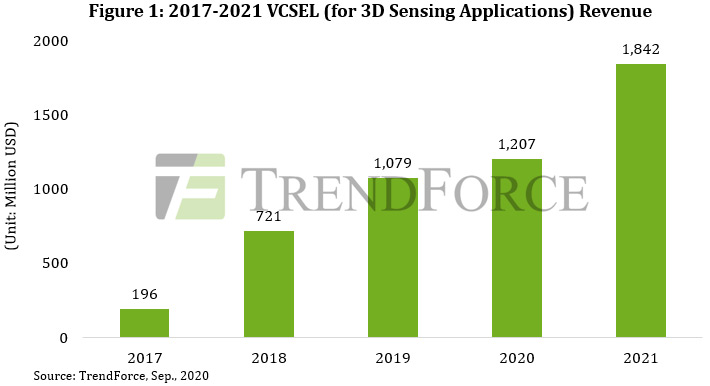News: Markets
3 September 2020
VCSEL revenue to grow 53% to US$1.8bn in 2021, driven by integration of 3D sensing and 5G
In early 2020, market research firm TrendForce forecasted the release of more than 10 high-end smartphone models equipped with 3D sensing solutions this year, which would drive up 3D sensing vertical-cavity surface-emitting laser (VCSEL) revenue (including whole 3D sensing infrared transmitter units) to US$1.404bn. However, as the COVID-19 pandemic put a damper on global smartphone shipment, and the Indian consumer market exhibited strong demand for entry-level and mid-range smartphone models, smartphone brand vendors have subsequently slowed down their pace of integrating 3D sensing solutions into high-end models. TrendForce is reducing its 2020 revenue forecast for 3D sensing VCSELs (for mobile devices including smartphones and tablets) to $1.207bn, a 12% increase year-on-year from $1.079bn in 2019.

Analyst Joanne Wu indicates that 3D sensing functions have become an indispensable part of flagship models as smartphone brand vendors engage in a spec war in this product segment. 3D sensing is mostly integrated into the rear cameras; its primary applications include range finding, background blur, 3D object detection, spatial modeling, and augmented reality (AR). In the future, 3D sensing functions are expected to be paired with 5G connectivity, in turn becoming a standard feature of high-end phones. Total revenue for 3D sensing VCSELs is projected to grow 53% year-on-year to $1.842bn in 2021.
The dominant suppliers of 3D sensing solutions currently include ams, Finisar, Osram, II-VI Inc, Lumentum, Sony, VPEC, LITE-ON, AWSC, and WIN Semiconductors. 3D sensing applications in the consumer electronics market include functions such as structured light, ToF (time of flight), and active stereo vision. In particular, ToF functions are integrated into a wide variety of applications due to their fast response times and long range.
At the moment, Apple and Samsung have each integrated ToF functions in their respective products, such as the iPhone and iPad Pro for the former and the S20+ and S20 Ultra 5G for the latter. In addition, direct ToF sensors are more power-efficient compared with other 3D sensing solutions. The integration of 3D sensing with 5G connectivity is expected to deliver a more interactive experience for users of mobile devices through functions such as gesture-control-enabled AR. Other possible 3D sensing applications are AR-assisted interior design, home renovation, home additions, and even integration with video games. 3D sensing solutions may even see cross-industry commercial opportunities in the future, concludes TrendForce.









